UK Climate Act
 Click logo to return to 'links-page'
Click logo to return to 'links-page'
Between 1990 and 1997 GCI created and conducted a global campaign at the UN
for the Contraction and Convergence model (C&C) for UNFCCC-Compliance.
C&C was agreed in principle at COP-3 in December 1997.
In July 2000, the Chairman of the Royal Commission on Environmental Pollution [RCEP] Sir Tom Blundell wrote a letter saying how much the RCEP valued GCI's pioneering work over the years making the case for 'Contraction & Convergence', adding this had enabled them to develop their own arguments more effectively.
C&C became the principal recommendation to the UK Government of the RCEP in 2000: -
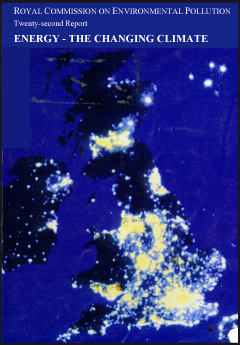
"The UK should continue to play a forceful leading role in international negotiations to combat climate change, both in its own right and through the European Union. The government should press for further reductions in the greenhouse gas emissions of developed nations after 2012, and controls on the emissions of developing nations. The UK government should press for a future global climate agreement based on the contraction and convergence approach, combined with international trading in emission permits. Together, these offer the best long-term prospect of securing equity, economy and international consensus."
"The UK-based Global Commons Institute has taken the lead in promoting contraction and convergence and has developed a computer model which specifies emission allocations under a range of scenarios. The concept has been supported by several national governments and legislators. Some developed nations are very wary of it because it implies drastic reductions in their emissions, but at least one minister in a European government has supported it. Commentators on climate diplomacy have identified contraction and convergence as a leading contender among the various proposals for allocating emission quotas to nations in the long term."
RCEP Table 4.1 Contraction and convergence: implications for UK carbon dioxide emissions |
||
maximum atmospheric concentration |
permissible UK emissions in 2050 % of 1997 level |
permissible UK emissions in 2100 % of 1997 level |
450 ppmv |
21 |
11 |
550 ppmv |
42 |
23 |
750 ppmv |
56 |
47 |
1000 ppmv |
58 |
61 |
"In table 4.1 RCEP has applied the contraction and convergence approach to carbon dioxide emissions, and we have calculated what the UK’s emissions quotas would be in 2050 and 2100 for four alternative upper limits on atmospheric concentration. We have assumed for this purpose that 2050 would be both the date by which nations would converge on a uniform per capita emissions figure and the cut-off date for national populations. If 550 ppmv is selected as the upper limit, UK carbon dioxide emissions would have to be reduced by almost 60% from their current level by mid-century, and by almost 80% by 2100. Even stabilisation at a very high level of 1,000 ppmv would require the UK to cut emissions by some 40% by 2050."
GCI NOTE: - It followed therefore that if 450 ppmv was selected as the upper limit, the UK carbon dioxide emissions would have to be reduced by almost 80% from their current level by mid-century, and by almost 90% by 2100.
As of 2008, the 80% cut by 2050 for the UK became the figure stated in the UK Climate Act.
"Energy - The Changing Climate" [2000]
The Royal Commission on Environmental Pollution

"This target was recommended in the report by the Royal Commission on Environmental Pollution (RCEP) published in 2000."
The appropriate UK share of a global emissions target involves ethical judgements and will be the subject of international negotiations. A range of methodologies for allocating emissions reductions between countries have therefore been proposed. Most of these methodologies base emission reduction targets on per capita emissions, abatement costs or income. They differ in relation to the time when different countries begin emissions reductions, the rate at which they then reduce emissions, and the extent to which already industrialised countries should have to compensate for historic emission levels. It is not part of the Committee’s remit to propose a specific methodology for the purposes on international negotiations. But we believe that it is difficult to imagine a global deal which allows the developed countries to have emissions per capita in 2050 which are significantly above a sustainable global average. In 2050 the global average, based on an estimated population of 9.2 billion, would be between 2.1 to 2.6 tonnes per capita, implying an 80% cut in UK Kyoto GHG emissions from 1990 levels.
Appropriate UK contributions to global emissions reductions
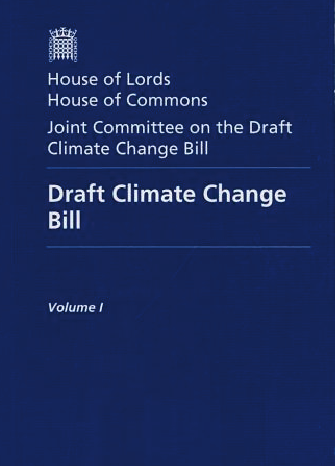
The 60% target
A key feature of the draft Bill is the long-term target of a 60% reduction in carbon dioxide by 2050. This target was first announced in the Energy White Paper of 2003, and, as the Government acknowledged in its oral evidence to us, was in response to a recommendation by the Royal Commission on Environmental Pollution (RCEP) in its influential report, Energy the Changing Climate, published in 2000.
The 60% target which the RCEP recommended was based on the adoption of the 'contraction and convergence' approach first advocated in 1990 by the Global Commons Institute. Contraction and Convergence involves calculating the maximum global level of emissions which could be regarded as 'safe', and apportioning these emissions to countries on an equal per capita basis. Some countries, in particular the carbon-intensive developed nations, would currently be well in excess of their apportioned amount and would need to radically reduce their emissions, while less developed countries would be allowed to increase their emissions.
Joint Committee on the Draft Climate Change Bill
UK House of Commons and House of Lords
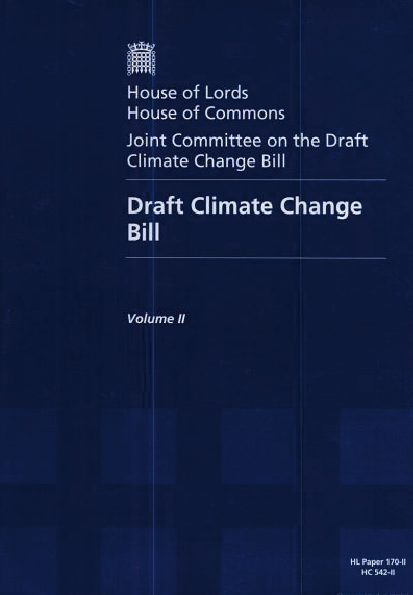
Contraction & Convergence repeatedly referenced by a range of witnesses to this enquiry by the . . .
Joint Committe on the Draft Climate Change Bill [Vol 2]
UK House of Commons and House of Lords
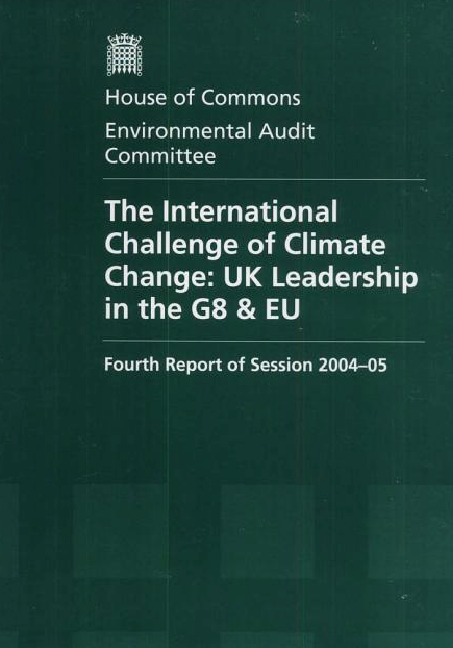
Contraction and Convergence
83. Such calculations provide an interesting and important perspective on the context in
which negotiations on a post-2012 framework should take place. The Global Commons
Institute (GCI) has been promoting the concept of equal per capita emission allocations
since its foundation in 1990, and it has coined the term “Contraction and Convergence”
(C&C) to describe its approach. C&C involves two distinct stages—firstly defining the level
to which global emissions need to be reduced to avoid dangerous climate change, and
secondly allocating this level of emissions to countries on an equal per capita basis.
84. The C&C model put forward by the GCI does not in itself define the mechanisms by
which emission reductions are to be achieved—whether through emissions trading,
international taxes, or regulatory approaches. Nor does it stipulate the actual level at which
emissions should be stabilised, or indeed the timescales over which the targets should be
set. It does, however, graphically illustrate the conse-quences of varying these parameters,
and provides a useful framework within which to set targets and frame policy responses. The real strength of the model, however, arises from the manner in which the concept of equity underpins it.
85. Given the scale of the reductions which are needed, there is now a growing awareness
of the need for a ‘full-term’ framework such as the one C&C provides. Indeed, it is difficult
to argue with the fundamental principle of equal per capita allocations, and various
witnesses—including the Under-Secretary of State of the Foreign Office and the Director-
General of the CBI—acknowledged the viability of the model. 68 This is also reflected in the
joint memorandum submitted by DEFRA and the FCO, 69 and in the recent report from
the International Climate Change Taskforce which explicitly accepted that equal per capita
emissions allowances should form the basis for a long-term solution. 70 While, in their
memo-randum to us, Barclays Capital set out a vision of an all-embracing international ETS
involving 60 year targets determined by a C&C approach. 71
86. Any framework which involves radical emission reductions would in practice
resemble the Contraction and Convergence approach advocated by the Global
Commons Institute. Indeed, in terms of domestic policy aims, the UK Government has already implicitly accepted this approach in adopting the 60% carbon reduction target for 2050; and it is therefore inconsistent not to adopt such an approach internationally.
We do not see any credible alternative and none was suggested in evidence to our
inquiry. We therefore recommend that the UK Government should formally adopt and promote Contraction and Convergence as the basis for future international agreements to reduce emissions.
The International Challenge of Climate Change
UK Leadership in the G8 & EU
UK Hoc Environmental Audit Committee
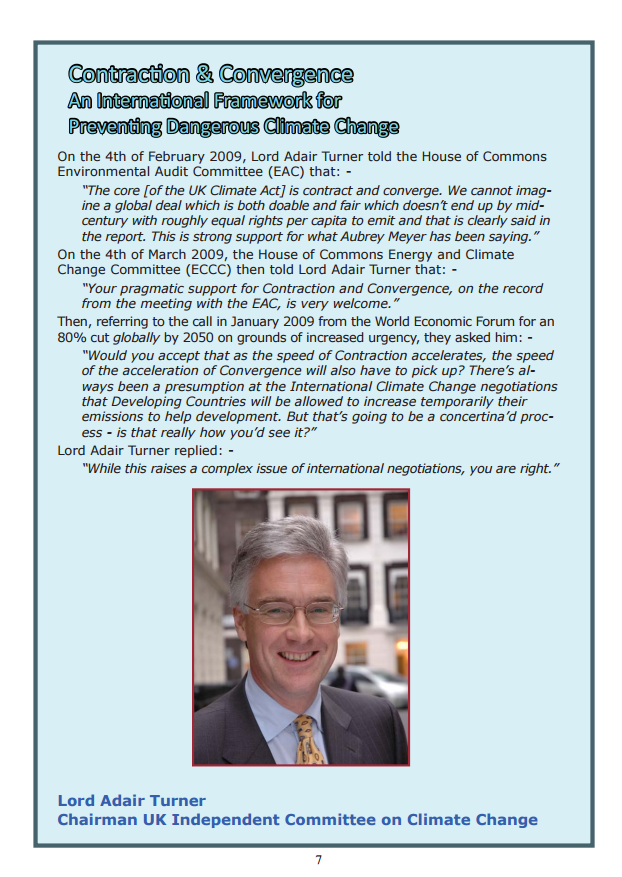
"Climate change is likely to impose massive
economic costs. The case for being prepared to spend huge
resources to limit it is clear,” says Turner, arguing that the cost will
be repaid many times over by the avoidance of disaster.
In any case, “the developed world does not have the moral
right to increase the risk of flooding in Bangladesh”, and, he
adds acidly, “European executives worried about the cost
of action should perhaps consider it the necessary price for
preserving at least some skiing in the Alps. Long term the only sound strategy is that of
‘contraction and convergence’ – cutting greenhouse emissions to
the point where they are shared equally, worldwide, on a per capita
basis.”
Lord Adair Turner -
Chairman UK Climate Change Committee
Interview
in Green Futures
Adair Turner characterised the UK Climate Act as C&C in evidence to the EAC and DECC select committees in 2009 saying that converging to equal per capita entitlements globally is the only option that is, "doable and fair" for organising and sharing the full-term emissions-contraction-event to bring us to UNFCCC-compliance. He agreed that, "if, for reasons of urgency the rate of global contraction has to be accelerated, for reasons of equity the rate of international convergence has to be accelerated relative to that.”
Evidence to House of Commons
Climate and Energy Committee
"Dear Mr Meyer, May I say that I have always had great admiration for the role you have played in proposing the broad principle that "convergence" of per capita emissions will in the long-term be reached."
Lord Adair Turner -
Chairman UK Climate Change Committee
Personal Letter to GCI, 16th June 2009
- In 2009, Adair Turner, then Chairman of UK Climate Change
Committee,
said in HoC that C&C is the basis of the UK Climate Act (UKCA): -"In the UK Climate Act we have
endorsed the C&C principle.
Its pretty strong support for what Aubrey Meyer has said. we didn't call it that - it became emotive for reasons I don't really understand."
(Looking at Assumptions here might help understanding statements of this nature) . . .
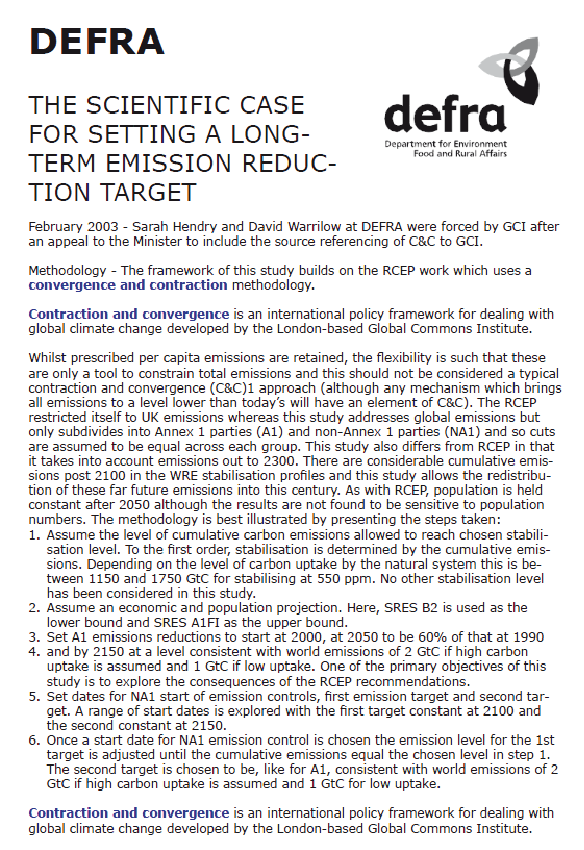
February 2003 - Methodology - The framework of this study builds on the RCEP work which uses a Contraction and Convergence methodology. Contraction and Convergence is an international policy framework for dealing with global climate change developed by the London-based Global Commons Institute.
Whilst prescribed per capita emissions are retained, the flexibility is such that these are only a tool to constrain total emissions and this should not be considered a typical contraction and convergence (C&C)1 approach (although any mechanism which brings all emissions to a level lower than today’s will have an element of C&C). The RCEP restricted itself to UK emissions whereas this study addresses global emissions but only subdivides into Annex 1 parties (A1) and non-Annex 1 parties (NA1) and so cuts are assumed to be equal across each group. This study also differs from RCEP in that it takes into account emissions out to 2300. There are considerable cumulative emissions post 2100 in the WRE stabilisation profiles and this study allows the redistribution of these far future emissions into this century. As with RCEP, population is held constant after 2050 although the results are not found to be sensitive to population numbers. The methodology is best illustrated by presenting the steps taken:
1. Assume the level of cumulative carbon emissions allowed to reach chosen stabilisation level. To the first order, stabilisation is detersmined by the cumulative emissions. Depending on the level of carbon uptake by the natural system this is between 1150 and 1750 GtC for stabilising at 550 ppm. No other stabilisation level has been considered in this study.
2. Assume an economic and population projection. Here, SRES B2 is used as the lower bound and SRES A1FI as the upper bound.
3. Set A1 emissions reductions to start at 2000, at 2050 to be 60% of that at 1990
4. and by 2150 at a level consistent with world emissions of 2 GtC if high carbon uptake is assumed and 1 GtC if low uptake. One of the primary objectives of this study is to explore the consequences of the RCEP recommendations.
5. Set dates for NA1 start of emission controls, first emission target and second target. A range of start dates is explored with the first target constant at 2100 and the second constant at 2150.
6. Once a start date for NA1 emission control is chosen the emission level for the 1st target is adjusted until the cumulative emissions equal the chosen level in step 1. The second target is chosen to be, like for A1, consistent with world emissions of 2 GtC if high carbon uptake is assumed and 1 GtC for low uptake.
DEFRA - The Scientific Case for Setting a Long-Term Emission Reductions Target
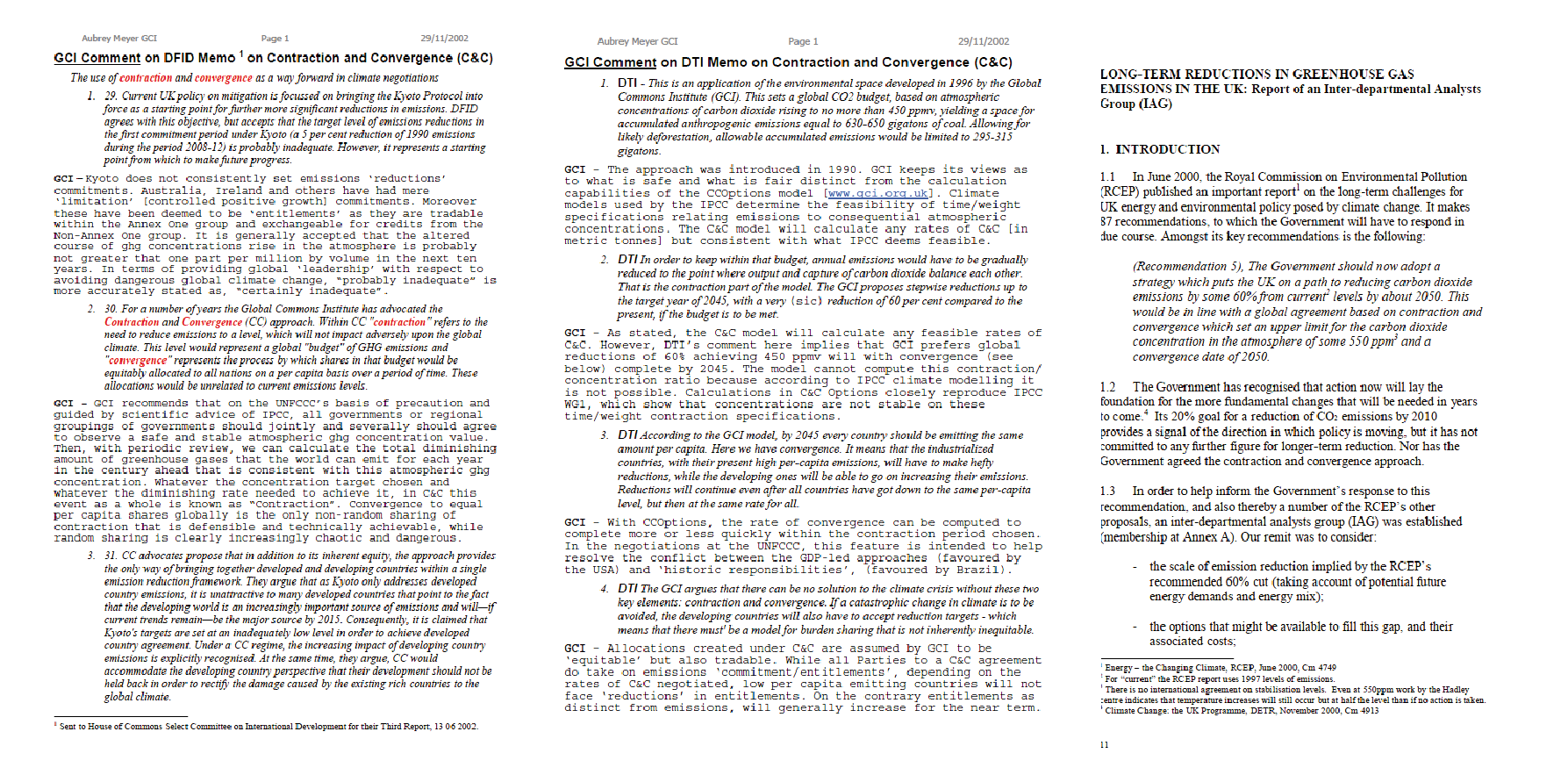
Three Whitehall Memos about C&C from DFID DTI
and IAG with commentary by GCI.

The emergence of varied views of C&C in DEFRA, DTI, DFID memos and the Cabinet Officies PIU Report led to GCI's letter to the Minister at DEFRA requesting full source-referencing of C&C in Government publications. This he agreed for reasons of, "Protecting the Integrity of the Argument": -
Letter from the UK Environment Minister Meacher agreeing the request
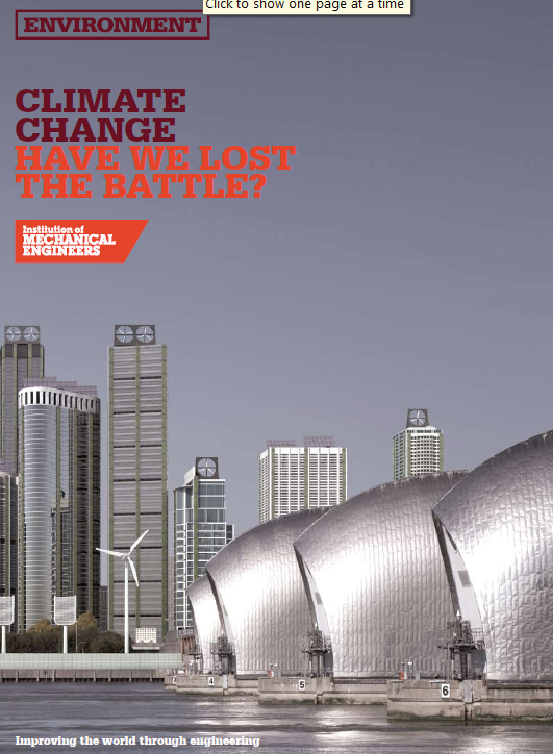
The Government’s targets and budgets have been set using a top-down approach based on the principle of contraction and convergence. This approach involves emissions from industrialised nations reducing (contracting). At the same time, emissions from all nations converge to an overall target consistent with stabilising greenhouse gas concentrations within the atmosphere at an
acceptable level. In this way, over time emissions will contract and converge to an equal share per person globally, regardless of the nation in which they live. The desire from most authorities is to constrain the global mean temperature rise to 2°C or below. This translates the contraction and convergence requirement to an 80% reduction target for the UK relative to 1990 levels by 2050
and the adopted budget profile through to 2020. The Institution of Mechanical Engineers supports the principle of contraction and convergence.
Climate Change - Have We Lost the Battle?
Institution of Mechanical Engineers
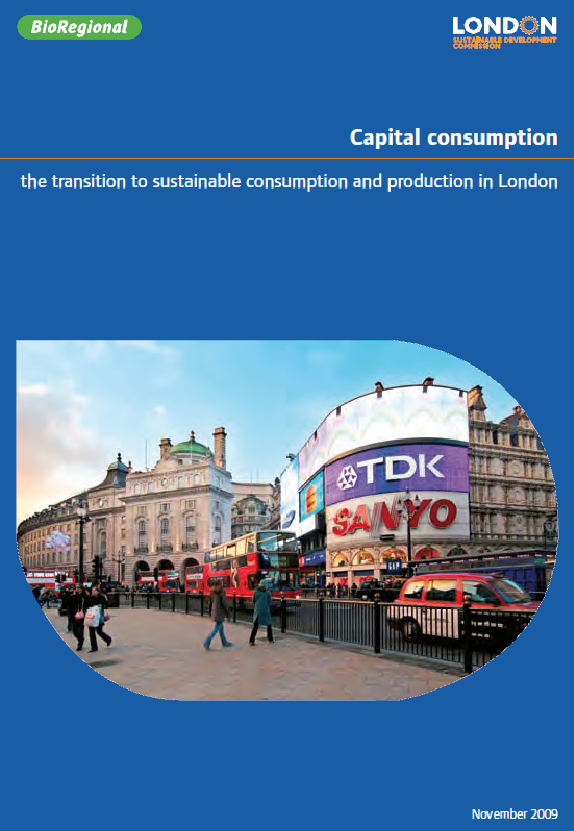
The UK Climate Change Act target of an 80%
reduction in CO2 by 2050 and the London
Climate Change Action Plan target of a 60%
cut by 2025 are both based on a ‘contraction and convergence’ model in which
by 2050 everyone in the world would be entitled
to an equal share of emissions with the aim of
atmospheric CO2 concentrations not exceeding
450ppm. This entitlement is roughly equivalent
to two tonnes of CO2 per person each year.
As UK and London emissions are currently
much higher than this (whether calculated on a
production or consumption basis), the targets are
based on the reductions needed to achieve an
equitable level by 2050.
Capital Consumption - Bioregional
the transition to sustainable consumption and production in London
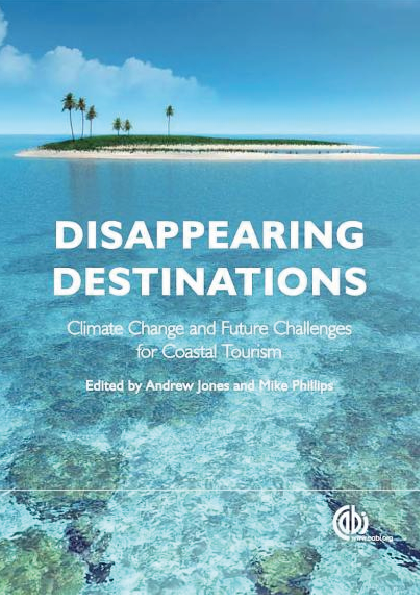
The Royal Commission on Envrionmental Pollution (RCEP) in its 22nd Report, Energy: The Changing Climate had, inter alia, already addressed these two issues with the Commission favouring the 'contraction and convergence' approach, which would allow an equaJ per-capita emission allowance to every citizen of the world, thus 'the result of this new allocation would, of course, be an enormous reduction for the current high emitters and some scope for emissions growth by developing countries What is interesting is the broad conclusion of the 22nd Report; a reduction
by industrialized countries of 60% or more by the year 2050, was formally adopted by tbe UK Government in the Energy 'White Paper of 2003 (OTI, 2003), only to be taken to a legally binding target of at least an 80% cut in greenhouse gas emissions by 2050 with a reduction in emissions of at least 34% by 2020 by
the Climate Change Act 2008.
Disappearing Destinations
Andrew Jones Mike Phillips

"I fully agree that the GCI's Contraction &
Convergence framework provides a realistic & equitable plan for global
action. That is why C&C was a key part of the Liberal Democrat's manifesto
and why I continue to believe the principle of C&C will be central to our
long-term strategy on climate change."
Nick Clegg Lib Dem MP [2010]
UK Deputy Prime Minister
’
"You know I agree, in the long term there is no other way to solve this problem.”
Chris Huhne Lib Dem MP [2010]
UK Secretary of State Energy & Climate

"Man-made climate change. Little progress can be made without fundamental agreement on the principle of 'Contraction and Convergence', as between high-income countries, which have generated the lion's share of the stock of carbon in the atmosphere, and the big low-income countries, which will contribute the greatest future emissions. Without China and India as full and equal partners in the process, it will fail."
Vince Cable Lib Dem MP [2009] -
UK Secretary of State Business
The Storm: The World Economic Crisis & What It Means

“Aubrey Meyer has done an amazing job and shown extraordinary persistence and ingenuity in working out a scheme of this kind. I very much admire him for it. Above all he’s laid out an intellectual and legal framework which is what you need if you’re going to set global arrangements in place.”
Sir Crispin Tickell, former UK Ambassador to the UN [2007]
Director of the Policy Foresight Programme James Martin Institute Oxford University

"GLOBE International adopted the "Contraction and Convergence" analysis
in May 1977. Since then, I and my colleagues have campaigned for its
acceptance. This pamphlet is a record of those efforts and provides a short
summary of the work of the Global Commons Institute (GCI) in this field. I
would like to pay tribute to all the GLOBE parliamentarians who have fought
so hard for this cause and particularly to the work of Aubrey Meyer and the
GCI team on whose brilliant analysis the campaign is based. If you read only one book on climate change,
its past and future, politics and solutions, read this one.
This is the global picture and the key to a global solution."
Tom Spencer Former Director GLOBE International
Chair European Parliament Foreign Affairs Committee

"Talking about why it is important that everybody in the world gets Contraction and Convergence [C&C]. I don’t say things like this lightly. I am not really one for hyperbole or strange religious motivations. What I find is important is that my whole life experience has taught me that things that have proportionality to them, that have melody to them, that are profoundly simple, usually have something right going for them. And secondly that you can judge an idea by the quality of the enemies it gets and there have been some profound enemies for C&C, which is based on an understanding that perhaps there is something of the night about it there is something not properly scientific. Well actually it is, it is totally scientific and more important than that it has blended something the age of reason was never able totally to do which is blending the empiricism of it with ‘soul’; the quite obvious rightness of a system that apportions to every person on earth a carbon contract that it theirs to dispose of over a period of time to create a parity that enables us to live one with another in a way that enables us to be connected to the earth itself in terms of being able to make us live with the grain of nature and not apart from it. I have yet to hear anyone provide an argument that makes it ethically unsound, however uncomfortable they may feel about it. I have yet to find someone who can scientifically disprove the work of Aubrey Meyer."
Tim Smit Chief Executive and Co-Founder of the EDEN Project

"Several ideas derived from Contraction and Convergence [C&C] have surfaced since Kyoto with ideas that can be perhaps in various ways incorporated into C&C. However, there is an overwhelming need for an over-arching UNFCCC-compliant Framework that enables the globally competing interests of the over-consuming and the under-consuming to be reconciled with each other and with the objective of the UNFCCC in a non-random manner.
We feel that C&C is the veteran and indeed the apex example of this and urge you to consider our request. At Kyoto in December 1997 and shortly before they withdrew from these negotiations, the USA stated, “C&C contains elements for the next agreement that we may ultimately all seek to engage in.”
The adversarial reasons for their withdrawal then were in play again at COP-15.
C&C answers this in a unifying and constitutional way and the need for this answer becomes increasingly critical."
Tim Yeo MP [2010]
Chairman of the House of Commons Energy & Climate Change Committee


"Let us recognize that a global deal has to be fully inclusive, demonstrate how we calculate burden-sharing and be equitable as no-one will accept a deal that builds in their disadvantage. That framework is Contraction and Convergence."
Too Little, Too Late: The Politics of Climate Change
Colin Challen - Former Chair UK HoC
All Party [2008]
Parliamentary Group on Climate Change
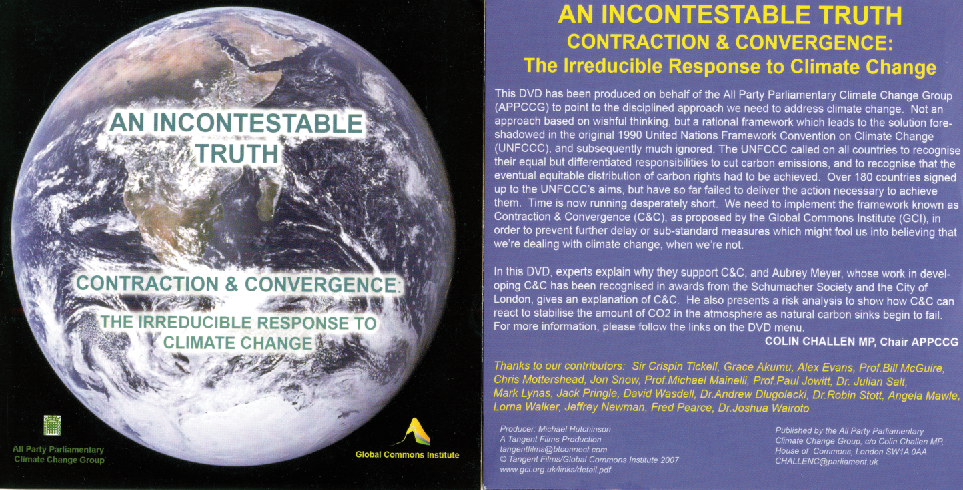
This DVD was produced on behalf of the UK House of Commons All Party Parliamentary Climate Change Group of MPs (APPCCG) by GCI and Tangent Films. It was distributed to all sitting UK MPs in 2007. It points to the disciplined approach we need to address climate change. Not an approach based on wishful thinking, but a rational framework which leads to the solution foreshadowed in the original 1990 United Nations Framework Convention on Climate Change (UNFCCC), and subsequently much ignored.
The UNFCCC called on all countries to recognise their equal but differentiated responsibilities to cut carbon emissions, and to recognise that the eventual equitable distribution of carbon rights had to be achieved. Over 180 countries signed up to the UNFCCC's aims, but have so far failed to deliver the action necessary to achieve them. Time is now running desperately short. We need to implement the framework known as Contraction & Convergence (C&C), as proposed by the Global Commons Institute (GCI), in order to prevent further delay or sub-standard measures which might fool us into believing that we're dealing with climate change, when we're not.
This DVD gives an explanation of C&C. Experts also explain why they support C&C and Aubrey Meyer, whose work in developing C&C has been recognised in awards from the Schumacher Society and the City of London. He presents a risk analysis to show how C&C can react to stabilise the amount of C02 in the atmosphere as natural carbon sinks begin to fail. For more information, please follow these links
Thanks to our contributors: Sir Crispin Tickell, Grace Akumu, Alex Evans, Prof. Bill McGuire,
Chris Motters-head, Jon Snow, Prof. Michael Mainelli, Prof Paul Jowitt, Dr. Julian Salt,
Mark Lynas, Jack Pringle, David Wasdel, Dr. Andrew Dlugolecki, Dr. Robin Stott, Angela Mawle,
Lorna Walker, Jeffrey Newman, Fred Pearce, Dr. Joshua Wairoto.
COLIN CHALLEN MP, Chair APPCCG
Contraction & Convergence - An Incontestable Truth [1]
The Irreducible Response to Climate Change [2]

UNFCCC-compliant Global Climate Change Framework
We all face an increasingly urgent situation with the threat of runaway rates of climate change occurring and the persistent failure to come to terms internationally to deal with this. There is an international need to establish a UNFCCC-compliant Global Climate Change Framework to redress this threat as soon as possible. Contraction and Convergence is a prime example of this. It is a rational formulation for reconciliation of 'Climate Justice without Vengeance'.
Sir Martin Rees from letter to Secretary of State [signed with 200 others].

"Contraction and Convergence is a beautiful model."
David Milliband at the Green Alliance
“One of my first parliamentary questions as a callow backbencher was about contraction and convergence [C&C - the proposition that regions with high per capita carbon emissions must contract them progressively to converge with those of current low emitters at a level that is globally sustainable]. I think any international agreement is going to have those principles at its heart - shared responsibility, equitable burden-sharing."
David Milliband in Green Futures

"There is an attractive justice element to the contraction and convergence idea."
Ed Milliband to the HoC Environmental Audit Committee 27 OCTOBER 2009
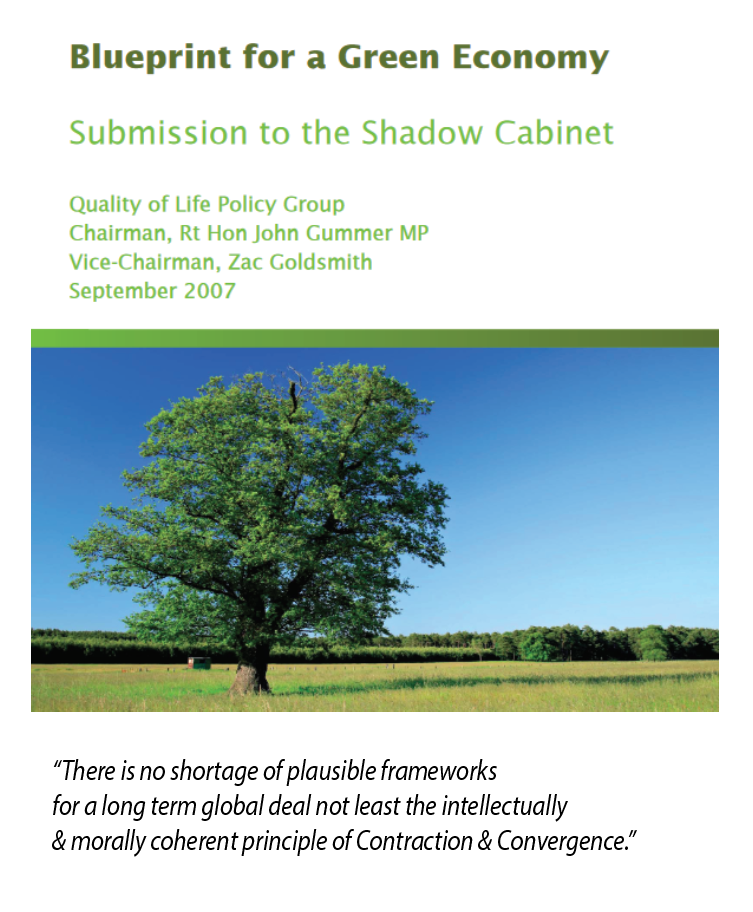

Jon Gummer David Cameron Zac Goldsmith
"There is no shortage of plausible frameworks for a long term global deal on the table, not least the
intellectually and morally coherent principle of Contraction and Convergence."
UK Conservatives Quality of Life Challenge
"Blueprint for a Green Economy" on C&C
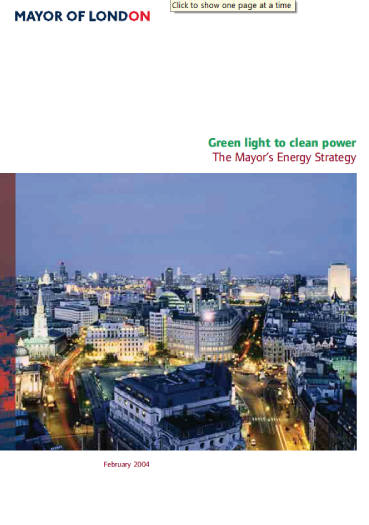
Contraction and convergence
Contraction and convergence is a simple approach to distributing the
total greenhouse gas emission reductions required internationally,
between various countries or groups of countries. The approach is based
on two principles:
1 there is an upper limit to acceptable global atmospheric
greenhouse gas concentration, beyond which the damage from climate
change would not be acceptable
2 the atmosphere is a global commons, so that as individuals we all
have equal rights to emit greenhouse gases. Contraction and convergence is arguably the most widely supported, equitable, global
approach to tackling climate change and the Mayor supports the principle of contraction and convergence. The contraction and convergence proposal was developed by the Global Commons
Institute, London. Details of its origins, methodology, and support are available online at http://www.gci.org.uk
Green light to clean power
The Mayor’s Energy Strategy
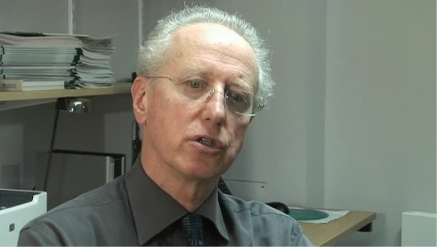
"Many congratulations on the endorsement from the UK Deputy Prime Minister and on your tremendous commitment sustained over many years to an equitable approach to climate action. Politically Contraction and Convergence [C&C] is the only credible approach which could be widely accepted."
Professor Sir Andy Haines University College London
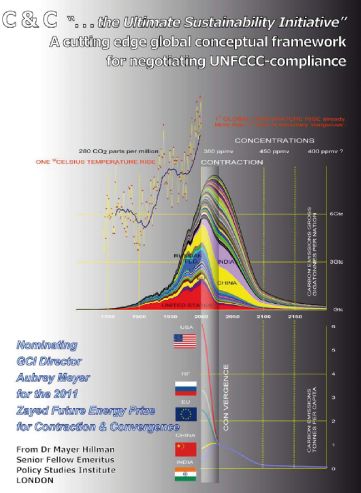
"Aubrey’s effort to keep the Contraction and Convergence [C&C] approach visible at the centre-ground of UN climate politics has substantially paid off. It resulted in the adoption and advocacy of C&C by the UK Royal Commission on Environmental Pollution [RCEP] in 2000. After that he published a body of evidence on C&C for the UK Parliamentary Select Committees who in turn have repeatedly published reports strongly advocating C&C to successive UK Governments. In the light of all these recommendations, this has resulted in the UK Climate Act [2008] being clearly based on C&C. Awarding this Prize to Aubrey Meyer for Contraction & Convergence, could be invaluable in achieving consensus on the global deal needed for success at the UNFCCC. It would not just be a recognition of his effort, it would send a strong signal to the UN saying that to survive, we must finally transcend the politics of blame and join together globally in this constitution for Climate Justice without Vengeance."
Nomination of Aubrey Meyer and ‘Contraction & Convergence‘ for Zayed Prize
by Dr. Mayer Hillman, Senior Fellow Emeritus, Policy Studies Institute, London
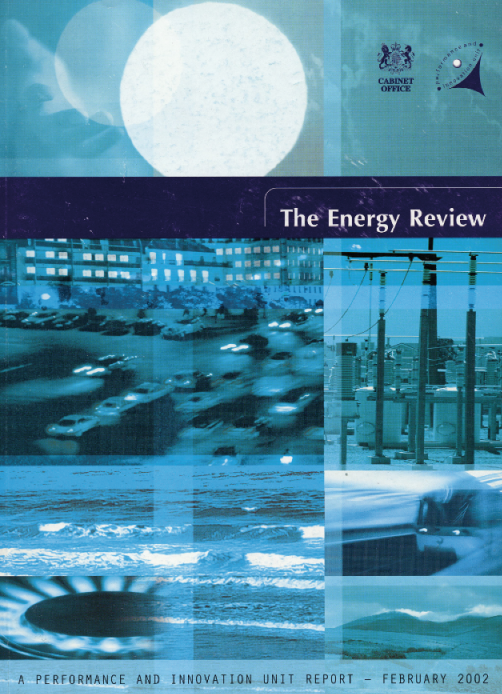
“The project’s outputs will be a key input to the UK
Government’s future policy on security and diversity of energy
supply and on climate change including its response to the Royal Commission on Environmental Pollution (RCEP) report on ‘Energy, the Changing Climate'. The centrality of carbon and the climate change issue”
The UK practices a ‘leading’ approach to climate change. This
approach to climate change implies 3 separate policy timelines with measures to: -
- comply with agreed targets;
- prepare for future targets not yet agreed but probably involving not all countries and operating for limited time periods, and
- prepare for a world of long-term emission limits agreed between all countries, possibly based on the principles of contraction and convergence.
There is no clear dividing line between these phases. Post-Kyoto targets affecting the UK could be finalised by 2005
but agreement might take longer, perhaps a lot longer, and the
scale of the next targets is uncertain. Likewise, it is possible
that we could be in a world of long-term universal targets by
2010.
There is even a remote possibility of moving directly to the final
phase from the current position.
In the same way, it is far from clear what the scale
of future targets will be. The RCEP suggested that a 60%
reduction for the UK by 2050 would be needed within a
contraction and convergence agreement, but the exact figure is
very uncertain. All that is certain, whether we move to a contraction and
convergence world, as suggested by the RCEP, or follow the
guidance produced by the IPCC about global levels of emission
reductions that will be needed to avoid dangerous climate
change, is that developed countries will need to make very substantial cuts from current emission levels over the century ahead."
PIU Energy Review
UK Cabinet Office
.